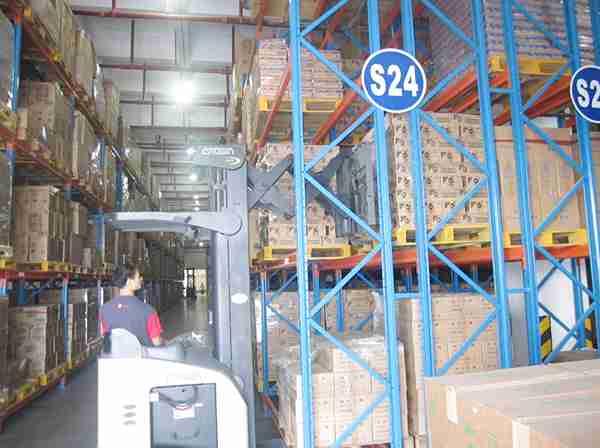📐 "First 50 Enterprise Queries Get Custom 3D Warehouse Design" Plan

Introduction: Transforming Warehouses with Smart Double Deep Racking System Design
In an era where every square foot of warehouse space counts, double deep racking system design has emerged as the gold standard for operations needing to maximize storage without compromising accessibility. Unlike conventional single-deep setups that waste valuable aisle space, this innovative approach stacks pallets two-deep—effectively doubling storage capacity while maintaining efficient material handling workflows.
This definitive guide explores every critical aspect of double deep racking system design, from structural engineering principles to real-world implementation strategies. Warehouse managers, logistics planners, and storage solution providers will discover actionable insights for creating optimized storage systems that deliver measurable ROI

H1: The Fundamentals of Double Deep Racking System Design
At its core, double deep racking system design represents an evolutionary leap in pallet storage technology. By positioning two pallet loads back-to-back in each bay, facilities achieve 80-90% storage density improvements compared to traditional selective racking configurations.
H2: Engineering Principles Behind Effective Double Deep Racking System Design
- Load Distribution Dynamics – The system’s upright frames must counteract unique torsional stresses created by deep storage loads
- Forklift Access Geometry – Careful calculation of aisle widths relative to forklift turning radii
- Dynamic Load Considerations – Accounting for seismic activity and forklift impact forces in the structural design
H2: Component-Level Breakdown of Double Deep Racking Systems
- High-Strength Uprights: 12-16 gauge steel columns with reinforced base plates
- Dual-Function Beams: Roll-formed steel with integrated safety locks
- Depth-Compensating Shuttles: Optional automated retrieval systems for LIFO applications
- Impact Protection Systems: Column guards and end-of-aisle barriers
H1: The Strategic Advantages of Optimized Double Deep Racking System Design
H2: Unmatched Storage Density Metrics
When properly implemented, double deep racking system design delivers:
- 85-110% more pallet positions than selective racking
- 30-40% better space utilization than push-back systems
- Comparable density to drive-in racks with superior accessibility
H2: Operational Efficiency Gains
- Reduced Travel Time: Narrower aisles decrease forklift transit distances
- Improved Inventory Turns: Strategic SKU placement optimizes picking routes
- Enhanced Safety Profile: Guided aisle systems minimize collision risks
H2: Cost Performance Benchmarks
| Metric | Double Deep | Selective | Drive-In |
|---|---|---|---|
| Cost/Pallet Position | 180 | 130 | 220 |
| Forklift Investment | 85K | 50K | 60K |
| Labor Efficiency | 85-95% | 70-80% | 60-70% |
H1: Advanced Implementation Strategies for Double Deep Racking System Design
H2: Site-Specific Design Considerations
- Floor Flatness Tolerance: ≤1/8″ variance over 10′ span for optimal performance
- Vertical Clearance Planning: Minimum 18″ overhead for forklift operations
- Seismic Zone Adjustments: Additional bracing requirements for high-risk areas
H2: Material Handling Equipment Integration
- Deep-Reach Forklift Specifications:
- 96″-144″ extended fork capability
- 6,000-8,000 lb load capacity
- 80-100″ load center rating
- Automated Guided Vehicle Compatibility:
- LIDAR navigation systems
- Pallet-positioning accuracy within ±0.5″
H2: Digital Twin Modeling for Layout Optimization
Leading operations now use 3D simulation software to:
- Test multiple double deep racking system design scenarios
- Identify potential throughput bottlenecks
- Validate equipment maneuverability before installation
H1: Overcoming Common Challenges in Double Deep Racking System Design
H2: Inventory Accessibility Solutions
- Hybrid Configurations: Combining double deep with flow racks for fast movers
- Dynamic Slotting Algorithms: AI-driven pallet positioning based on turnover rates
- Cross-Aisle Retrieval Systems: Side-shifting forklift attachments
H2: Maintenance and Longevity Best Practices
- Quarterly rack alignment inspections
- Ultrasonic testing for hairline fractures
- Galvanized coating maintenance protocols
H2: Safety Enhancements for High-Density Operations
- Photoelectric aisle monitoring systems
- Anti-collapse wire mesh decking
- Overhead load stabilizer bars
H1: The Future of Double Deep Racking System Design
Emerging innovations set to transform the industry:
- IoT-Enabled Racking: Real-time load monitoring sensors
- Robotic Pallet Handlers: Fully automated deep lane retrieval
- Adaptive Storage Systems: Reconfigurable bay dimensions
Conclusion: Evaluating Double Deep Racking System Design for Your Operation
The decision to implement double deep racking system design requires careful analysis of:
- Current and projected inventory profiles
- Available capital expenditure budget
- Workforce technical capabilities
For operations storing large quantities of similar SKUs with moderate turnover, this solution delivers unparalleled space efficiency. Operations requiring instant access to every pallet may benefit more from hybrid configurations combining double deep with selective lanes.
FAQs: Expert Insights on Double Deep Racking System Design
1. How does double deep racking system design impact insurance premiums?
Properly engineered systems often qualify for 10-15% premium reductions due to enhanced safety features.
2. What’s the minimum warehouse size for effective double deep implementation?
Systems become cost-effective at ~15,000 sq.ft., with optimal ROI above 30,000 sq.ft.
3. Can existing selective racking be converted to double deep?
Partial conversions are possible but require professional engineering assessment.
4. How does double deep racking system design affect WMS requirements?
Most modern WMS platforms support double deep configurations with specialized module add-ons.
5. What maintenance intervals ensure long-term system integrity?
Professional inspections every 6 months, with daily visual checks by operators.




